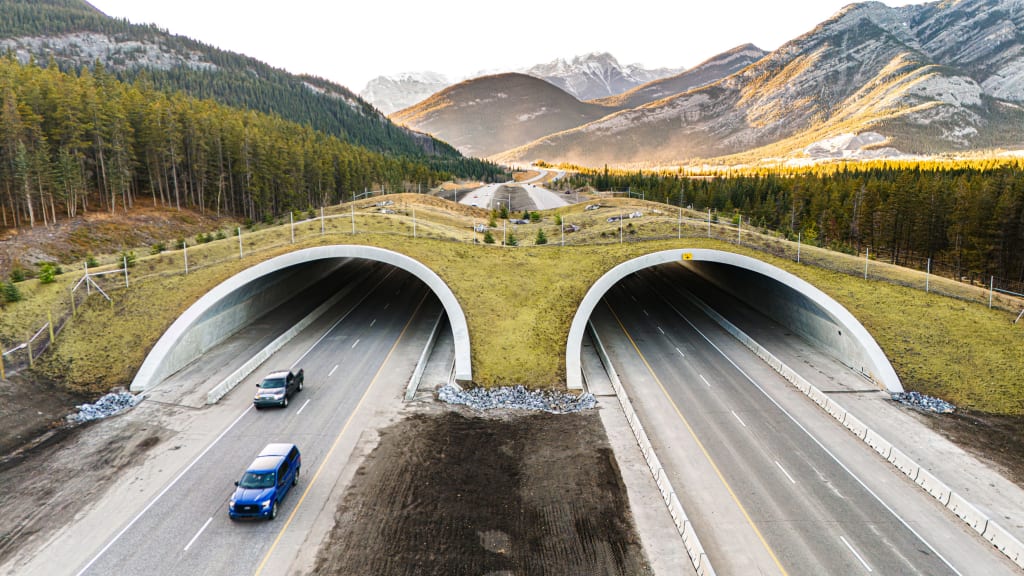In the heart of Alberta, Canada, a unique construction offers an innovative solution to a dangerous problem. This incredible wildlife overpass reconnects two sections of forest divided by the bustling Trans-Canada Highway. Animals can now cross safely, reducing collisions with vehicles. The clever design blends seamlessly into the natural surroundings, creating a lifeline for wildlife and ensuring human safety.
Nestled between Calgary and Banff National Park, this overpass is more than just a bridge. It’s a testament to what collaboration between wildlife biologists, ecologists, and designers can achieve. The structure is covered in lush greenery, carefully planned to mimic the surrounding forest. This new addition aims to significantly reduce the average of 69 animal-vehicle collisions per year.
A New Beginning for Wildlife and Drivers
Stretching across the Trans-Canada Highway, this innovative overpass is about 200 feet wide. It serves as a bridge to safety for local wildlife like deer, elk, coyotes, and grizzly bears. Before its existence, these creatures faced fatal risks just to cross the road. Now, this new path helps them migrate safely and keeps drivers out of harm’s way.
Design and Collaboration
The overpass was designed by Dialog, a firm well-versed in bringing such projects to life. Their collaboration with Alberta’s transportation department marks the first wildlife overpass outside a national park in Canada. This project shows how pooling expertise from different fields can yield groundbreaking results.
Wildlife biologists played a crucial role right from the initial design phases. They informed key aspects such as the width and topography, considering the animals’ needs and behaviors. Dialog’s Neil Robson explained that details like flatter topography and open viewpoints are essential for animals to feel safe.
Engineering Safe Passageways
The overpass rests on two arched tunnels covering the highway lanes. From a driver’s standpoint, this resembles a smooth, natural hill. The surface is covered with grass, shrubs, and trees, imitating the natural environment. A tall fence guides animals directly to the overpass, further enhancing its effectiveness.
The fencing extends over seven miles along the road, ensuring that animals are steered to use the overpass. This prevents collisions and maintains the ecosystem’s connectivity. Robson emphasized that while fences are effective, without an overpass, they isolate animal populations by blocking normal migration routes.
Careful attention was paid to plant selection for the overpass. Scientists chose species that fit the natural flora without encouraging animals to linger too long. The aim was to create a natural-looking passageway, not a feeding ground, for wildlife.
Insights from Animal Migration Patterns
The structure was informed by extensive research into local wildlife behavior. Designers used migration data to shape the overpass. The goal was to accommodate the size and habits of large species known to travel in this region, providing a path that feels safe and familiar to them.
Lines of sight and the absence of blind corners are critical elements. These ensure prey can spot predators and feel secure when using the overpass. The thoughtful design facilitates natural movement patterns, mimicking the environment the animals are accustomed to.
Robson pointed out that this project has set a new standard for wildlife overpasses. Its success is already influencing future designs, with Dialog planning three more overpasses in Canada. Each aims to build on these insights, offering safe passage for wildlife across busy roadways.
Lessons from Banff’s Innovations
Dialog is no stranger to wildlife overpasses, having previously designed several in Banff. These experiences provided a rich learning ground for the Bow Valley Gap project. In Banff, similar designs effectively reduced wildlife collisions, setting a precedent for future constructions.
By closely observing and measuring the effectiveness of these previous projects, the team could apply learnings to the current overpass. Fine-tuning design elements, such as grading and planting, were part of an iterative process informed by real-world data.
Dialog’s multidisciplinary approach, blending engineering with biology, has been key to the success of these overpasses. It’s not just about erecting structures; it’s about creating a true gateway for animals, ensuring their survival and safety.
The Challenge of Coexistence
This project symbolizes a shift in how infrastructure can be combined with nature. It goes beyond conventional construction methods, showing that roads and wildlife habitats can coexist.
Building such structures involves understanding various animal behaviors and their responses to man-made environments. The goal is to ensure seamless integration between wildlife needs and human development.
The overpass in Alberta is a pioneering step toward demonstrating that we can build smarter, more considerate infrastructures. It ensures that the needs of wildlife are not an afterthought but an integral part of planning.
Visual Harmony and Functionality
The overpass succeeds in blending with its surroundings, mimicking the natural landscape. From a distance, it appears as just another hill, preserving the scenic beauty of Alberta.
Such design decisions were intentional, artfully balancing aesthetics with functionality. This harmony ensures that the overpass not only works but also respects the visual integrity of the environment.
The Bow Valley Gap overpass stands as a testament to what is possible when environmental protection and modern infrastructure go hand in hand. It provides a model of how such projects can become integral parts of our landscapes.
The Future of Wildlife Overpasses
As the first of its kind outside a national park in Canada, this overpass sets new benchmarks for future structures. It showcases the potential to replicate this model in other regions facing similar challenges.
Dialog is already using insights gained here to design additional overpasses. This approach looks set to spread across Canada, promoting safer roads and richer ecosystems.
With ongoing monitoring and adaptation, these structures promise to evolve continually, offering wildlife new lifelines as they adapt to changing environments.
The wildlife overpass in Alberta represents a vital step forward in harmonizing transport infrastructure with natural ecosystems. By allowing safe passage for animals, it not only protects species but also enhances road safety for humans. This project paves the way for future innovations, promising a safer and more connected world for all.





